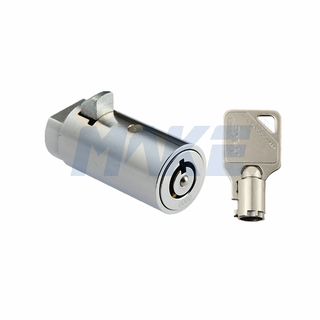Security has always been a top priority for both individuals and businesses. From protecting valuables in a retail showcase to securing sliding glass doors at home, a reliable lock can make the difference between peace of mind and vulnerability. Among the wide range of locking mechanisms available, the lock plunger stands out for its simplicity, versatility, and effectiveness.
A lock plunger is a small but crucial component of many lock systems. It is the part of the mechanism that extends or retracts to secure or release the locking device. In practice, this means that when the plunger is engaged, it fits securely into a slot, preventing doors, drawers, or cabinets from being opened. When disengaged, the mechanism allows smooth access.
Lock plungers are most commonly used in sliding doors, cabinets, showcases, and drawers, where they act as a barrier to prevent unauthorized access. Retailers often rely on them to protect merchandise, while homeowners install them in furniture or glass doors for added security.

To understand the function of a lock plunger, it helps to think of it as part of a larger, straightforward system. A plunger lock, often compared to the pin tumbler lock, uses a simple yet highly effective design that has remained popular for decades.
Here’s how it works step by step:
The lock plunger consists of a cylindrical housing, a keyway (where the key is inserted), and a set of pins or tumblers inside the cylinder. These pins come in varying lengths and are positioned vertically.
In its locked position, the upper ends of the pins extend into both the keyway and the housing. This prevents the cylinder from rotating, thereby keeping the lock secure.
To unlock the mechanism, the correct key must be inserted. Each key has a unique arrangement of ridges and valleys that correspond exactly to the positions of the pins.
When the key is turned, the ridges push the pins either up or down inside the cylinder.
When the key is correct, all the pins align perfectly along what is called the shear line—the precise gap between the inner cylinder and the outer housing.
Once the pins align, the cylinder can rotate freely, releasing the plunger. This disengages the bolt or latch, allowing the door, cabinet, or drawer to open.
What makes this mechanism brilliant is its simplicity. Without the exact key, the pins remain misaligned, blocking the cylinder from turning. This ensures that only authorized access is granted, which is why plunger locks remain highly secure despite their compact design.
Lock plungers are designed with both practicality and security in mind. Some of the most notable features include:
A built-in spring mechanism ensures smooth operation, making the lock easy to use and reliable in daily applications.
This feature enhances security by ensuring the lock engages firmly when in place.
Users can choose whether the key remains in the lock when opened (key-retaining) or can be removed at any time (non-key-retaining).
Many lock plungers allow quick re-keying, letting users adapt the lock to a different key combination without replacing the entire device.
The adaptability of lock plungers makes them suitable for a wide range of uses across both residential and commercial settings. Some common applications include:
Retailers use lock plungers to protect items on display, ensuring products remain visible to customers but secure against theft.
Lock plungers are widely used in stores for glass display cabinets, allowing staff to easily lock or unlock items when needed.
Certain plunger lock designs are used in vehicles and motorcycles, securing compartments or accessories.
Compact plunger locks can be adapted to secure bicycles in lightweight locking mechanisms.
Homeowners install them in sliding glass doors, cabinets, and drawers for a balance of accessibility and protection.
This versatility makes the plunger lock an attractive choice for anyone who needs security combined with convenience.
Depending on user requirements, lock plungers come with different cylinder options, including:
Each lock is operated by its own unique key. Ideal for securing individual items or areas.
Multiple locks can be opened with the same key, simplifying access management. Perfect for businesses with several display cases or storage units.
A master key system allows individual keys for each lock, while a master key can unlock them all. This is particularly useful for retail supervisors, facility managers, or security personnel.
When selecting a lock plunger, there are several important factors to keep in mind:
Decide whether you require a basic lock for general use or a high-security option for valuable items.
Match the lock to its intended use. For example, locks for retail showcases may differ from those designed for sliding doors.
Ensure the dimensions fit the door, cabinet, or drawer you are securing. Compatibility is crucial for effective installation.
Choose between keyed different, keyed alike, or master keyed systems depending on your convenience and security requirements.
Opt for high-quality materials such as stainless steel or brass, which resist corrosion and extend the lock’s lifespan.
Consider locks that can be easily re-keyed or serviced, reducing long-term costs.
The lock plunger’s appeal lies in its balance of security, simplicity, and versatility. It doesn’t require complex electronics or heavy mechanisms, yet it provides dependable protection for everyday use. Its compact size, straightforward operation, and adaptability across different environments make it a preferred solution for both homeowners and businesses.
By offering customizable keying options, durable construction, and easy re-keying, the lock plunger ensures users can tailor it to their needs without sacrificing security.
The lock plunger may seem like a small component, but it plays a big role in modern security. From protecting merchandise in retail markets to securing personal belongings at home, this versatile device provides peace of mind through its clever yet simple design.
Its pin-based mechanism ensures that only the right key can unlock it, while its flexible features and cylinder options make it suitable for countless applications. Whether you are a retailer, a homeowner, or a business operator, investing in a quality lock plunger ensures that your valuables remain safe, accessible only when you want them to be.
In today’s world, where both convenience and security are essential, the lock plunger delivers on both fronts—making it a smart choice for anyone seeking reliable protection in a compact, user-friendly form.
1 result

